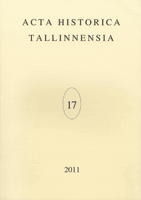SAKSA MIGRATSIOONIST LIIVIMAALE KESKAJAL
THE GERMAN MIGRATION TO LIVONIA IN THE MIDDLE AGES
Author(s): Priit RaudkiviSubject(s): History
Published by: Eesti Teaduste Akadeemia Kirjastus
Keywords: GERMAN MIGRATION ; LIVONIA ; MIDDLE AGES; Estonia; Estonian History;
Summary/Abstract: In the history of Estonia and Latvia the German minority group was an integrated part of the local society for centuries. The Germans played an important role starting from the second half of the 12th century up to the year 1939 when Umsiedlung, the violent retreat of the Germans to their “homeland”, took place. The Baltic German historiography as a scientific discipline began to evolve rapidly in the second half of the 19th century. One of its dominant feature’s was the emphasis on the role of the German invaders as the builders of the local medieval entry. Far more: the historiographers of Baltic German origin tried to build a solid bridge between the identity of medieval Germans and those of the 19th–20th centuries. No doubt, the Baltic German tradition of history writing owns much to the historiography of the newly established Reich in 1871. The most favoured analytical tool for both historiographical traditions was “nation” (the Germans). According to the author of the present article the notion was evidently misused because its content of the 19th–20th centuries cannot be exploited in medieval context. The second critical remark concerns the statement of strong solidarity/unity of the German invaders in the course of the local state-building emphasised by the Baltic German historians. Although we can assume that at the very beginning of the invasion there might have been some sense of belonging, it was abolished in the middle of the 13th century. Two events can be considered crucially important: firstly the incorporation of the Order of Brothers of the Sword into the Teutonic Order; secondly building up the archbishopric of Riga, which provided the Holy See with power to appoint local high clergy. The new framework cut off the supposed sense of unity among the Germans. Much more: the members of the military and spiritual orders and the high clergy cannot be considered the forerunners of the Baltic Germans because after both Catholic structures were abolished its members had no bloodline successors. One of the main features of the Baltic German historiography of Livonian history is that it has always been seen as the history of the Germans foremost. The role of the native peoples as co-builders of the medieval society has been diminished to extreme. The historiographical tradition of the Baltic Germans has been so high-powered that for the newborn history writing of the natives (the Estonians and the Latvians) it has not been possible to outmatch its weaknesses. The general understanding of the framework of the local medieval entry with the idea of the dominant role of the Germans composed by the Baltic German historiography has been accepted. According to the present state of the understanding of the medieval quasi-colonial societies, the role of the locals in the building of the entry could have been more substantial.
Journal: Acta Historica Tallinnensia
- Issue Year: 2011
- Issue No: 17
- Page Range: 016-036
- Page Count: 21
- Language: Estonian

